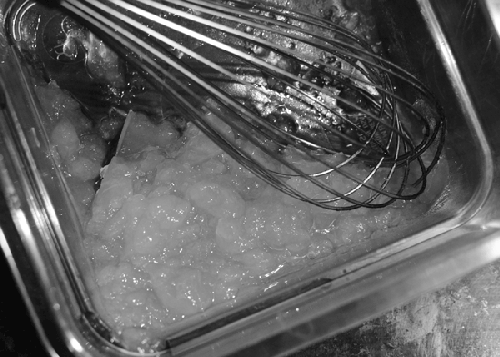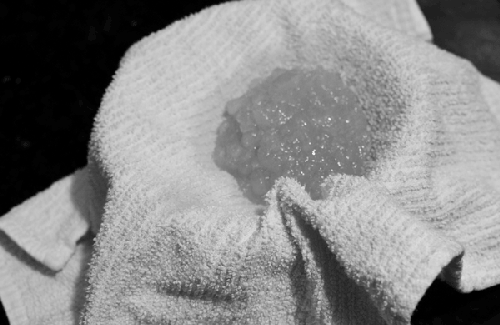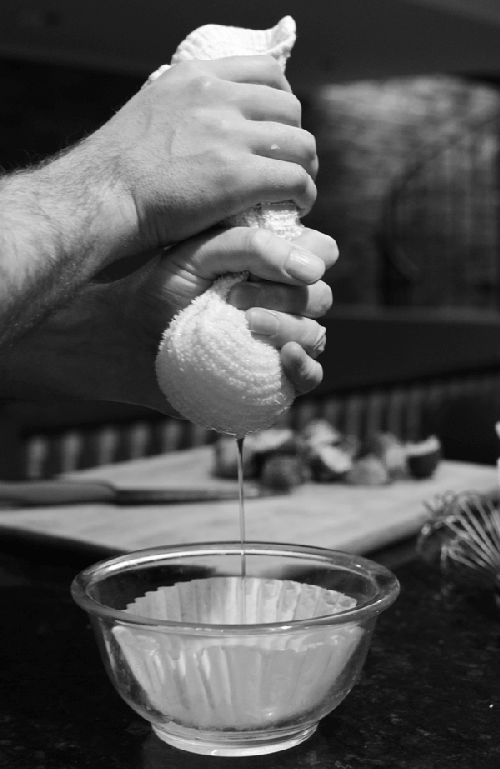Dave Arnold teaches at the French Culinary Institute in New York City,
where he instructs students about modern techniques and equipment.
How do you get someone to make the mental leap, to think
analytically, and to think outside the box, while in the kitchen?
For people who don’t naturally think this way, you can’t expect them to start
organically. You just want to give them another set of tools to work with in the
kitchen. So we take something that they take for granted, like cooking eggs, and then
break it into a zillion little components. We set up grids where we manipulate single
variables. This means that we look at two variables at once in a grid format—for
example, time against temperature—and manipulate one variable to see how it affects
the other.
One of the classic examples is coffee. The variables are knowable, but why is so
much coffee, specifically espresso, terrible? There are plenty of people that have
machines that are good enough. It’s good to think analytically. If you’re messing
around with coffee and you’re changing x, y, and z, it’s the equivalent of standing in
front of a big control board with a bunch of dials and then just spinning the dials.
To teach someone to make good coffee, you have to teach them how to lock down all
their variables and then alter them one at a time. When you’re making espresso, most
people choose to alter their grinds as their variable. They find that it’s easier to
lock in the temperature, the dosing, the pressure, and then manipulate grinds. It
teaches them how to manipulate variables and think analytically about
something.
If we’re trying to figure out the variable of temperature with eggs, we’ll just do
it. I’ll use a circulator to cook 10 eggs at very precise temperatures. We’ll do it
multiple times and we’ll crack them and see what the behavior is. Or we’ll teach
people how to make grids to test two different variables in order to figure out
something like the effect of heat on searing meat. We’ll set up a tasting grid and
they can taste it. I think this helps people to pick up that skill. It’s all about
control and the ability to observe.
What sort of hardware have you repurposed for the
kitchen?
Basically, a chef is going to want to steal anything that can help them heat
differently or homogenize or blend differently. Most of what we use that has been
repurposed aren’t necessarily our own ideas. You can crib things off of other people.
Everyone is using liquid nitrogen now, which is fantastic stuff.
Even stuff normally found in the kitchen we just use in a different way. A lot of
people are doing interesting work with pressure cooking nowadays. We use ultrasonic
cleaners and rotovaps a lot. We’ve been running some experiments on torches recently.
Why do things that are hit with torches taste like torch? I’m beginning to think that
it’s the component added to gases to make them smell so that you can tell when you
have a leak. I think the torch flavor is due to not fully combusting all of the stinky
stuff. I wanted to crisp something big, and so I fired up the roofing torch with
propane, and it didn’t taste bad. I tried to shoot a regular torch through a screen to
see whether we could combust any of the torch smell by capturing it on the screen and
blowing it through. That also works.
How do you balance experimenting with
safety?
Teach yourself as much as you can about the risks involved with any potential new
endeavor. The Internet is also good for that, because there are plenty of people
who’ve already hurt themselves. Do a lot of research; read a lot of things. There’re a
lot of opinions out there, and what one person says may not necessarily be true. It
doesn’t take too much Googling around to find out that someone has already tried to
carbonate something by sticking dry ice in a soda bottle and gotten a bunch of
shattered plastic in his face as a result.
You don’t want to stifle anyone’s creativity or their desire to hack around and do
things, because that’s the fun of it. But it has to be tempered with a certain amount
of base knowledge. Things are dangerous under three circumstances: one, if you don’t
know the procedure at all. That’s what happened to the soda bottle
guy. He didn’t know the procedures. Two, you’re completely frightened of something, a
piece of equipment or a knife. If you decide to use it anyway, you’re more likely to
get hurt. Three, when you become complacent. If you’re an inherently cautious person
and you don’t become complacent, that’s the safest way to do these kinds of
experiments.
What about the safety of used equipment, such as lab
gear?
When I got my centrifuge, we bleached and pressure-cooked any parts that would
touch any food. When I got my rotovap, I soaked that sucker in a bleach solution and
then in boiling water, and then boiling water and bleach. You have biological
contaminants and you have poisonous contaminants—all sorts of contaminants. I feel
pretty okay that with stainless and glass I can get rid of most bad inorganic stuff,
but you just have to pray that you wash enough to get rid of all the organic stuff.
From a biological hazards standpoint, you’re worried about prions, you’re worried that
someone has been blending up cow brains doing Creutzfeldt–Jakob research or something
like that. You can’t cook it away, they’re heat-stable. Then you’re counting on
mechanical washing.
I’m curious, what do you do with a
centrifuge?
A lot of people buy centrifuges because they think they’re going to get awesome
results with a centrifuge. What you really need to do is borrow someone else’s first.
All a centrifuge does is separate things based on density.
If you’re cooking, you want a lot of product, because you want to serve a lot of
people. It’s not often feasible. Unilever donated a centrifuge to us, and I had more
time just to play around. Now we’re doing a lot of things like making our own nut
oils, or clarifying things like apple juice, where we’re spinning it down to increase
our yield. Also, you can blend olives, cured ones like kalamata, and then you spin
them. It breaks into three layers. You have the best olive brine ever for a dirty
martini, hands down. You have a completely flavorless middle layer you throw away.
Then you have a really interesting layer of olive oil from cured olives. That’s kind
of fun. Expensive, though.
We’re taking things into the kitchen that aren’t from the kitchen, not just
laboratory equipment. There’s a whole group of people that make their own chocolates.
They use a stone grinder from India that’s used to grind dahl. We’ve taken that, and
we’re making things that have the textural properties of chocolate, which aren’t
related to chocolate at all, like ketchup and mustard. Most stuff in the kitchen is
going to be equipment-based, but it’s not necessarily new technology or lab
technology. Sometimes it’s just learning new techniques. It’s more of an
attitude.
I’ll give you another example: how are you supposed to cook mushrooms? You’re not
supposed to soak mushrooms. They always tell you to wipe off your mushrooms.
I usually just do a quick wash. My take has always been
that it doesn’t actually absorb that much water.
It actually does. Mushrooms are little sponges, but here is the thing: our
contention has always been that it’s just going to take longer to cook. Which is true.
We did a test where not only did we soak the mushrooms in slice form but then crowded
the pan—all the things that you’re not suppose to do with a mushroom.
The amazing thing was not that it didn’t make a difference in cooking them, but
that the ones that we had soaked and crowded were better. The
reason is because while the soaked mushrooms are sitting there giving off their water
and stewing in their own juices, they’re collapsing. It’s no longer a sponge to soak
up oil, so by the time all the water had boiled off and they started sautéing they had
already collapsed, and they weren’t absorbing the oil. The non-soaked mushrooms, at
the end of sautéing, had soaked up all of the oil and in fact wanted more oil. The
ones that had been soaked hadn’t even absorbed all of the oil. Some of the oil was
still left in the pan.
So just by normal observation, because we had measured things and were trying to
figure out what was going on, we realized that everything that they teach you about
mushrooms is wrong. You’re not going to measure every time, but you would never pick
up on stuff like that unless you were really thinking analytically about what’s going
on.
I think it’s actually the key to a lot of this. I think
there is a certain something that drives some people to go to lengths, when other
people just kind of shrug their shoulders and end up not being as
curious.
Right, and that’s why Harold McGee’s website is called “The Curious Cook.” A lot
of it is about curiosity and then after curiosity—and here’s where the real geek thing
comes in—is the ability and willingness to actually do something about the curiosity.
Go the stupid extra length. Just see whether you can do it.
The UK magazine
Intelligent Life did a piece on Dave Arnold, including the “stupid extra
length” he went to to make a perfect gin and tonic. Dave explains:
It was called the $10,000 gin and tonic because there was all this equipment and
time, and rotary evaporation, and the PSI measured carefully, and clarifying juices,
etc. I was redistilling lime essence to create a clear lime juice so that I could add
that to my quinine simple syrup and gin and get the water level exactly where I wanted
it and carbonate it. The reason you want it clear is because gin and tonic should be
clear, and should have enough bubbles, and the right alcohol content. So I was able to
break out every single variable and recombine them exactly the way I wanted.
The idea of the original recipe, Bottle Strength G ’n T, was
to produce a gin and tonic shot at bottle strength (80 proof). To do it, we distilled
lime juice and gin to capture the fresh volatiles from the juice and increase the
proof of the gin. We then added acids back to the distillate to recreate the flavor of
the lime juice, along with sugar and quinine, the bitter part of tonic water. Why all
this? Adding sugar, acid, etc. lowered the proof of the gin. If we wanted to serve
bottle-strength gin and tonic shots, we had to raise the initial proof. Plus,
distilling the lime volatiles gave us a perfectly clear drink that carbonates well
(pulp is a carbonation killer). We no longer serve this version, because it only
tastes good at around 0°F / –18° C. Served any warmer than 5°F / –15° C, and it tastes
unbalanced; any colder than –9°F / –23° C, and it is painful going down. It was hard
to get people to drink quickly enough, when the shots were at the right
temperature.
This same technique, when watered down to 15–20% alcohol by volume, produces our
perfect G ’n T, and it’s much easier to do. I use what we call simple agar
clarification on lime juice. I can do it in 20 minutes on a camp stove
and I don’t need the high-end equipment to make it. It’s back to a normal cost in
terms of equipment, except for a carbonation rig. The good news is that it’s very
inexpensive to get a real carbonation rig at home. The whole carbonation rig costs
well under $200. A single 20-pound tank of CO2 costs about $20
to refill, and it makes 200 to 400 gallons of seltzer or liquor. Everyone should have
one in their house. Everyone.
Clarified lime juice. Squeeze the juice from 10
limes into a container, running through a sieve to remove pulp. Weigh the juice; it
should be around 500g. Set aside.
In a pan, create an agar gel using water and agar. Measure out a quarter of the
amount of lime juice in water, roughly 125g of water, and create a 10% agar gel,
around 12g (this will result in a 2.0% concentration once mixed with the lime juice).
Once the agar has melted, remove from heat and pour the water-agar mixture into the
container with the lime juice and let it rest for half hour or so, until set.
Once the lime gel has set, use a whisk to break the gel into pieces.
Take the whisk and make zigzag slashing cuts; don’t actually whisk the
gel.

Transfer the broken gel to a cheesecloth (real cheesecloth, not the
loose mesh stuff) or towel. Fold the cloth up into a ball.

Hold the balled cloth above a coffee filter and squeeze it with your
other hand, massaging it to force out as much liquid as possible. (The coffee
filter will catch any small chunks of agar that happen to leak
through).

Simple syrup with quinine. Create a simple
syrup (2 parts sugar, 1 part water), then add diluted quinine sulfate. Be careful!
Quinine in anything other than minute quantities is poisonous! The legal limit is 83
parts per million of quinine, which is 0.083 grams of quinine sulfate per liter of
liquid. You will need considerably less than this. Quinine goes from pleasantly bitter
to extraordinarily bitter rather quickly. Make a solution of 1g quinine sulfate in 500
ml of water (or gin) and use no more than 40 ml of this solution per liter of finished
product and you will be okay. You will probably like less than half that
amount.
To assemble:
4 oz gin
2 oz clarified lime juice
Simple syrup with quinine to taste
Salt to taste
Chill in freezer. Carbonate to 40 PSI.